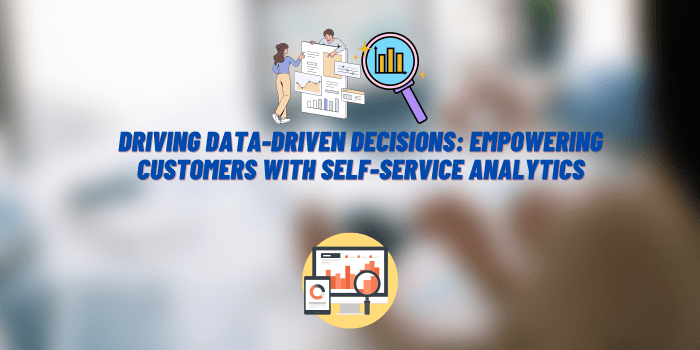Driving Data-Driven Decisions: Empowering Customers with Self-Service Analytics
Self-service analytics are becoming more and more popular as customers continue to benefit from data-driven decisions in many sectors of the economy. In this article, we will explore the rise of self-service analytics, its key features, and how it empowers customers to make data-driven decisions effectively.
We at Double Cloud decided to discuss the challenges associated with self-service analytics and strategies to ensure successful implementation. Additionally, industry examples will demonstrate the transformative impact of self-service analytics in decision-making processes. Let’s begin!
The Rise of Self-Service Analytics

Definition and Key Features of Self-Service Analytics
Self-service analytics refers to the practice of enabling users to independently access, analyze, and visualize data without relying on IT or data experts. It involves user-friendly interfaces, intuitive tools, and functionalities that allow individuals, regardless of their technical expertise, to explore and derive insights from data.
Adoption of Self-Service Analytics in Various Industries
Self-service analytics has gained significant traction across diverse industries such as retail, finance, healthcare, and manufacturing. Organizations are embracing self-service analytics to empower their customers and employees. The availability of user-friendly tools and the increasing availability of data have fueled its adoption.
It continues to grow in popularity exactly because of the incredible value of data-driven decisions for all parties.
Empowering Customers with Self-Service Analytics

Self-service analytics is a transformative tool that empowers customers to harness the full potential of their data, enabling them to make data-driven decisions with confidence. Through its accessibility, real-time insights, customization, and collaboration capabilities, self-service analytics revolutionizes how individuals interact with and derive value from data.
Accessibility and Ease-of-Use
Self-service analytics platforms offer user-friendly interfaces and intuitive tools that make data analysis accessible to non-technical users. These tools eliminate the need for coding or complex queries, enabling individuals without extensive data expertise to navigate through the data analysis process.
With drag-and-drop functionality, pre-built templates, and guided workflows, users can easily explore, analyze, and visualize data, unlocking valuable insights without relying on IT or data experts.
Real-Time Insights
Traditional analytics processes often involve time-consuming cycles of data extraction and analysis. In contrast, self-service analytics provides users with direct access to real-time data sources. This means that customers can obtain up-to-date information instantly, allowing them to make decisions based on the most current data available.
Real-time insights enable businesses to respond quickly to market changes, identify emerging trends, and capitalize on new opportunities, giving them a competitive edge in today’s fast-paced business landscape.
Enhanced Customization
The level of personalization offered by these solutions allows customers to derive insights that directly align with their business objectives. Self-service analytics tools often provide advanced filtering and segmentation capabilities, enabling users to drill down into the data, apply filters, and perform in-depth analyses.
Collaboration and Sharing
Self-service analytics platforms foster a collaborative environment by facilitating knowledge exchange and teamwork. Users can share reports, visualizations, and insights with colleagues, promoting collaboration and collective decision-making.
By encouraging collaboration and sharing, self-service analytics platforms create opportunities for cross-functional teams to collaborate, align their efforts, and achieve common goals. This collaborative approach enhances the quality of decision-making by incorporating diverse perspectives and expertise.
Overcoming Challenges and Ensuring Success

Becoming a data-driven organization is hard, says Amazon. Even so, you can realistically use this data to great effect. There are, however, several challenges and issues they need to address, first.
Data Quality and Governance
Maintaining data quality is crucial for obtaining accurate and reliable insights. Organizations should establish data validation processes, data cleansing techniques, and data quality monitoring mechanisms.
By implementing clear data governance policies and standards, organizations can ensure data accuracy, consistency, and integrity. Regular data audits and quality checks should be conducted to maintain high-quality data throughout the self-service analytics process.
Security and Privacy Concerns
As self-service analytics involves granting access to data, organizations must prioritize data security and privacy. Robust security measures, such as role-based access controls, encryption, and data anonymization techniques, should be implemented to protect sensitive information.
Data access permissions should be carefully managed to ensure that users have access only to the data they require for their analysis. Organizations should also adhere to relevant data privacy regulations and industry standards to maintain compliance and build trust among customers.
Training and Support
To fully leverage the power of self-service analytics, organizations need to provide comprehensive training and ongoing support to users. This includes offering training programs, workshops, and educational resources to help users develop data analysis skills and understand the capabilities of the self-service analytics tools.
Effective documentation and knowledge bases can serve as valuable resources for users to troubleshoot issues and find answers to their questions. Establishing a support system, such as a dedicated helpdesk or community forums, can provide users with the necessary assistance and foster a collaborative environment for sharing best practices.
Industry Examples
Self-service analytics has proven to be a valuable asset across various industries, empowering organizations to make data-driven decisions and derive actionable insights. Let’s explore a few industry examples where self-service analytics has made a significant impact:
- Retail sector. In the retail industry, self-service analytics plays a crucial role in inventory management and customer insights. Retailers can leverage self-service analytics to analyze sales data, inventory levels, and customer buying patterns.
- Financial services. The financial services industry benefits greatly from self-service analytics, enabling customers to analyze their investment portfolios and track financial performance.
- In the healthcare sector, self-service analytics facilitates data-driven decisions for improved patient care and operational efficiency. Healthcare providers can analyze patient data, medical records, and treatment outcomes using self-service analytics tools.
These industry examples illustrate how self-service analytics enables organizations in to leverage data effectively, driving growth, improving customer experiences, and enhancing operational effectiveness. It’s a long road to creating a proper data architecture within an organization, according to Infoworld.
However, by harnessing the power of self-service analytics, businesses can unlock valuable insights and make informed decisions in a rapidly evolving business landscape.






